After two long posts featuring panorama and cropping techniques, today a short post featuring long legs.

Now you have to admit, that’s a lot of leg! What you see is four foraging Black-necked Stilts. Relative to their body, their legs are extremely long and only topped by flamingos, so their name fits them rather well. The two in the front are males and the two in the back, with the more brownish mantle, females.
The Black-necked Stilt is usually found in the shallow waters of mudflats, estuaries, lakes and other types of wetlands. There it feeds on vertebrates and small fish that live in and on the soft substrate. As with many so-called shorebirds, the long legs come in handy when wading through the water, keeping the rest of their body dry.
This crop is about 20% of the original, shot with my D300 and the 70-200mm, at 2.8. With this lens I had to be quite close. Rather than chasing the birds, I just waited at a good spot. Once the birds got used to my presence they came foraging very close to me. Although the afternoon light was a bit harsh, I felt that the nice line-up and their reflection made up for most of it.


